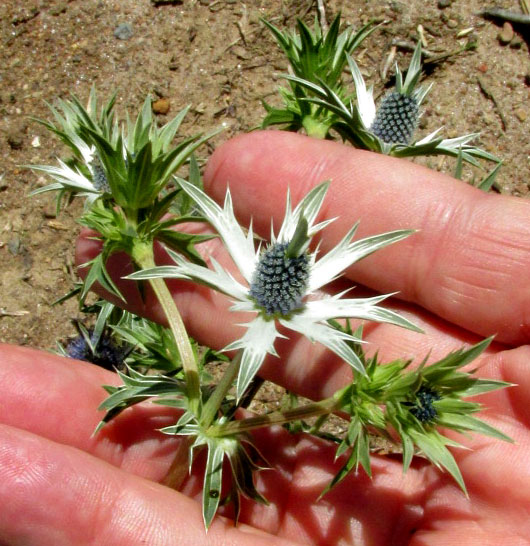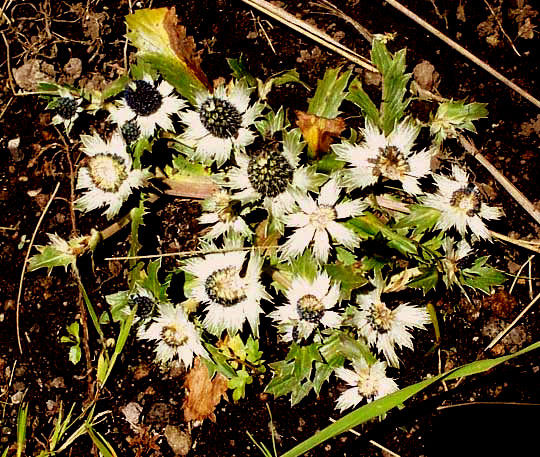Excerpts from Jim Conrad's
Naturalist Newsletter
entry dated September 11, 2022, notes from San Pedro Huimilpan, elevation about 2400m (7900ft), N20.315° W100.281°, Querétaro state, MÉXICO
HIERBA DEL SAPO

In a grassy fruit orchard on a mountain slope at the eastern side of San Pedro Huimilpan, the above wildflower appeared wherever there was a bare spot or disturbed soil. Many people who hike in high mountains will recognize this as a certain kind of plant often turning up on cold, windswept slopes. Its spiny, thistle- or teasel-like form with egg-shaped flowering heads subtended by collar-like, sometimes ornamental modified leaves called bracts, frequent such spots worldwide, though they're not restricted to them. The various species sometimes are known as eryngos.

Above, with my fingers providing some scale, you can see that this is a small species, though the individual in the photos is larger than most I've seen of the species. I think of this as a dwarf species. Besides its smallness, the species also is distinguished by the bright whiteness of the surfaces of the bracts below the pineapple-like flowering head. While many species of this group don't produce the item looking like leaves sprouting from atop the flowering head, the comas, this species' comas are especially well developed.

Up close, individual blue flowers can be seen. Each flower bears a five-lobed calyx, five petals, five stamens, two styles, and the ovary is inferior, meaning that the petals and stamens arise above the ovary, not at the ovary's base.
If you're familiar with the main families of flowering plants, the entire genus this plant belongs to may throw you for a loop. Our plant belongs to the Parsley/Carrot Family, the Apiaceae or Umbellifereae. That family usually is easily recognized because its flowers are arranged in simple or compound umbels, an umbel being a flower cluster in which stalks of nearly equal length arise from a common center and form a flat or curved surface. So, where are the umbels here, and the flower stalks of nearly equal length?
The experts say that the pineapple-like flowering head itself is a simple umbel, but it's unlike any umbel I've seen in any plant family. The genus here is Eryngium, whose species in English often are called eryngos.
About 220-250 Eryngium species are recognized, occurring worldwide, but with a center of diversity in South America. Mexico is home to maybe 50. In our area, if you have a small eryngo whose leaf veins are arranged in a reticulated manner (not parallel as with the grasses), a conspicuous coma sprouts from atop the inflorescence, and the upper surfaces of the collar-like involucre at the base of the inflorescence are brilliantly white and conspicuous, you have ERYNGIUM CARLINAE.
Eryngium carlinae has no English name, but in Mexico the species consistently is known as Hierba del Sapo, more or less "Toad Plant." Several species of Eryngium use the same name, as do other unrelated species that often look a bit strange, and therefore must have something to do with toads.
This species occurs in weedy places, scrubland and pastures as well as pine and conifer forests in the highlands, up to 3950m (13,000 feet). It's distributed from mountainous Chihuahua in the north, south throughout the uplands into Central America.
The online Atlas de las Plantas de la Medicina Tradicional Mexicana informs us that in central Mexico our plant's main traditional medical use has been for kidney problems, though it's also good for stomach and intestinal problems. The whole plant is boiled and taken orally. In older literature a number of other cures are listed.
In 2017, Luis Alberto Raul Montes Moreno published "Efecto del extracto acuoso de Eryngium carlinae (hierba del sapo) sobre marcadores bioquímicos de enfermedades no transmisibles" in which this conclusion was reached: That the enduring use of the Mexican people, previous studies with rodents, and the result of his own studies all indicate that an infusion of Hierba del Sapo at 1% concentration can help reduce and/or control high levels of serum triglycerides, and help reduce body fat and weight.
on lower slopes at about 3450m (11,300ft) of Nevada Toluca Volcano above Toluca, Mexico State, Mexico, in October, 2007
A DWARF ERYNGO
The "One-headed Eryngo" {Eryngium proteiflorum} was abundant above the treeline but below the treeline the one-headed species fairly disappeared. However, in disturbed soil, especially in grassy areas, a dwarf eryngo species turned up, entire plants usually being no larger than the One-headed's single head. You can see the dwarf species below:

Despite the huge difference in sizes, note that the dwarf species still possesses all the basic eryngo features: Tiny flowers in heads, spininess, and stiff leaves. The dwarf species keys out to ERYNGIUM CARLINAE.